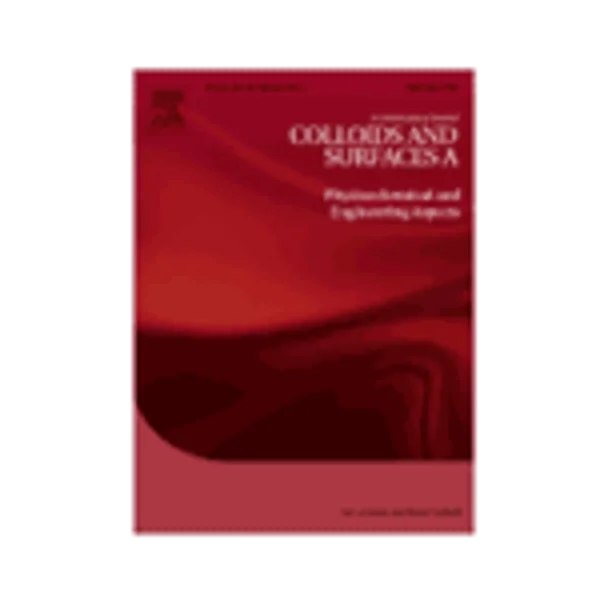-
effect of structure and bonding on the interfacial properties and the reactivity of layered double hydroxides and zn hydroxide salts
جزئیات بیشتر مقاله- تاریخ ارائه: 1392/07/24
- تاریخ انتشار در تی پی بین: 1392/07/24
- تعداد بازدید: 984
- تعداد پرسش و پاسخ ها: 0
- شماره تماس دبیرخانه رویداد: -
both layered double hydroxides (ldhs) and zn layered hydroxide salts (lhss) are intercalation compounds with potential applications as pollutant sorbents and antimicrobial, drug, and pesticide carriers, among others. their reactivity and interfacial properties are essential to these applications and dependent on the layer structure and interlayer anion nature. in this work, the structure and bonding of zn–cr ldhs and znlhss intercalated with chloride, 4-chlorobenzoate, and 4-chlorobenzylsulfonate were analyzed using x-ray diffraction and infrared spectroscopy. afterwards, their effect on interfacial properties and reactivity was assessed by zeta potential measurements, contact angle determinations, and hydroxide anions uptake. due to their different structure, ldhs presented electrostatic interactions between their layers and the intercalated anions, while lhss portrayed coordinated binding. the latter exhibited neutrally or negatively charged particles and ligand exchange reactions, while ldhs presented positively charged particles and anion exchange reactions. the interlayer anion nature also modulated the behavior of these solids: the introduction of aromatic anions strongly modified the hydrophilic/hydrophobic character of the surface, while their ionizable group determined the anion binding strength and consequently the anion/ligand exchange equilibrium of ldhs and lhss.
مقالات جدیدترین رویدادها
-
استفاده از تحلیل اهمیت-عملکرد در ارائه الگوی مدیریت خلاقیت سازمانی و ارائه راهکار جهت بهبود
-
بررسی تاثیر ارزش وجوه نقد مازاد بر ساختار سرمایه شرکت های پذیرفته شده در بورس اوراق بهادار تهران
-
بررسی تأثیر سطح افشای ریسک بر قرارداد بدهی شرکت های پذیرفته شده در بورس اوراق بهادار تهران
-
بررسی تأثیر رتبه بندی اعتباری مبتنی بر مدل امتیاز بازار نوظهور بر نقد شوندگی سهام با تأکید بر خصوصی سازی شرکت ها
-
تأثیر آمیخته بازاریابی پوشاک ایرانی بر تصویر ذهنی مشتری پوشاک ایرانی (هاکوپیان)
-
مینرال شیمی اپیدوت در پهنه های دگرسانی هیدروترمال منطقه ی قمصر، جنوب کاشان
-
همبستگی عزت نفس و پیشرفت تحصیلی در دانشجویان توانبخشی دانشگاه علوم بهزیستی و توان بخشی تهران
-
عملکرد جاذب انرژی تسلیمی در بهسازی لرزه ای ساختمانهای بتن مسلح متداول
-
بررسی میزان بروز عود تشنج در بیمارانی که با اولین تشنج بدون عامل مستعد کننده حاد مراجعه می کنند
-
ارزیابی اثر باد بر روی ساختمان های با پلان مستطیل شکل
مقالات جدیدترین ژورنال ها
-
مدیریت و بررسی افسردگی دانش آموزان دختر مقطع متوسطه دوم در دروان کرونا در شهرستان دزفول
-
مدیریت و بررسی خرد سیاسی در اندیشه ی فردوسی در ادب ایران
-
واکاوی و مدیریت توصیفی قلمدان(جاکلیدی)ضریح در موزه آستان قدس رضوی
-
بررسی تاثیر خلاقیت، دانش و انگیزه کارکنان بر پیشنهادات نوآورانه کارکنان ( مورد مطالعه: هتل های 3 و 4 ستاره استان کرمان)
-
بررسی تاثیر کیفیت سیستم های اطلاعاتی بر تصمیم گیری موفق در شرکتهای تولیدی استان اصفهان (مورد مطالعه: مدیران شرکتهای تولیدی استان اصفهان)
-
شیوه های گسترش اسلام در مغرب اسلامی در دو قرن نخست هجری، اسلام خوارج، اسلام اموی، اسلام شیعی فاطمیان و ادریسیان
-
بررسی تاثیر ارزش بر بازیهای چند نفره گسترده مجازی مورد مطالعه : مراکز خدمات اینترنتی در استان هرمزگان
-
محدوده و آثار اعتراض به قرار منتهی به بازداشت
-
رابطه هوش اجتماعی با سبک های شناختی تنظیم هیجان سازگار در دانشجویان دارای احساس غربت دانشگاه ملی ملایر
-
computational investigation of the efference of different fullerenes on aktogen high energy




سوال خود را در مورد این مقاله مطرح نمایید :